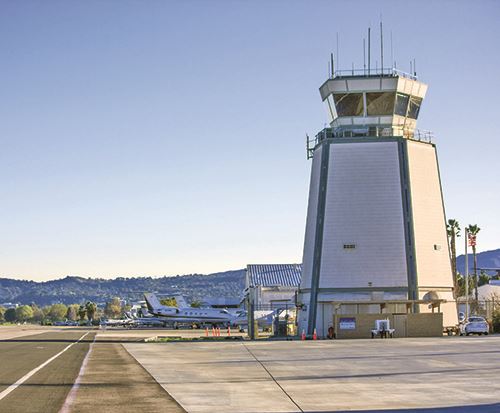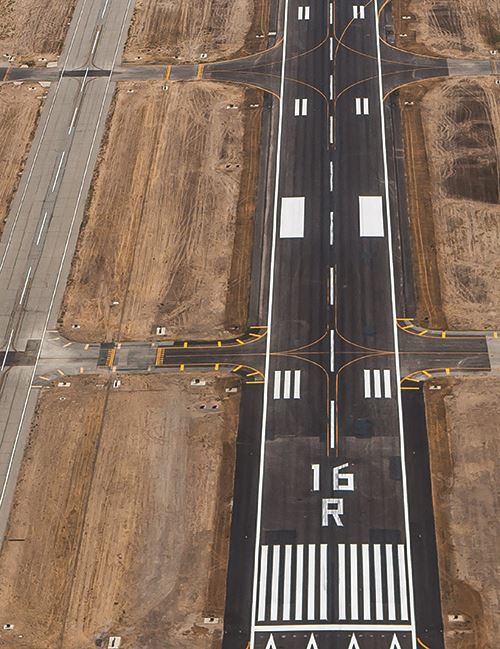When it becomes necessary to shut down one of your two main runways for reconstruction, careful planning is critical. The stakes are even higher when you manage one of the busiest general aviation airports in the United States. That was the challenge Justin Erbacci, chief executive officer of Los Angeles World Airports, faced earlier this year regarding Van Nuys Airport (VNY).
When it becomes necessary to shut down one of your two main runways for reconstruction, careful planning is critical. The stakes are even higher when you manage one of the busiest general aviation airports in the United States.
 That was the challenge Justin Erbacci, chief executive officer of Los Angeles World Airports, faced earlier this year regarding Van Nuys Airport (VNY). After consulting with tenants and stakeholders at the Southern California airport and engaging with engineering and design consultant HNTB, it was apparent that the time had come to reconstruct 16L-34R, the airport’s 4,000-foot runway. To do so, VNY closed the runway for six months—from February to August 2022.
That was the challenge Justin Erbacci, chief executive officer of Los Angeles World Airports, faced earlier this year regarding Van Nuys Airport (VNY). After consulting with tenants and stakeholders at the Southern California airport and engaging with engineering and design consultant HNTB, it was apparent that the time had come to reconstruct 16L-34R, the airport’s 4,000-foot runway. To do so, VNY closed the runway for six months—from February to August 2022.
When planning the reconstruction, Erbacci and his team also opted to budget for maintenance to the airport’s other runway, 16R-34L, which is twice as long. Crews applied an asphalt slurry seal to its surface from early August to Sept. 1, during two midweek closures and a series of night shutdowns.
|
Project: Runway Reconstruction Location: Van Nuys (CA) Airport Est. 2022 Operations: 300,000 Project Budget: $19.1 million (includes cost to repave other runway) Funding: $17.37 million FAA Airport Improvement Program grant Design: 2020 & 2021 Closure to Reconstruct 16L-34R: Feb.-Aug. 2022 Runway Length: 4,000 ft. Repaving 16R-34L: Early Aug.- Sept.1, 2022 Runway Length: 8,000 ft. Main Contractor: Sully-Miller Engineering & Design Consultant: HNTB Drainage & Hydrology: VCA Engineers Inc. Geotech: Ninyo & Moore Electrical Contractor: Royal Electric Main FBOs: Castle & Cooke; Clay Lacy; Jet Aviation; Signature Flight Support Construction Hours: 76,000 Percentage of Local Workers: 43.4% LED Lights: ADB SAFEGATE Signs: Lumacurve Benefits: Reconstructed Runway 16L-34R expected to serve traffic for several decades; new pavement & lighting for Runway 16R-34L improves safety & visibility |
Together, the two runway projects had repercussions throughout the airport. VNY is expected to have more than 300,000 operations this year, and is home to more than 200 tenants, including large FBOs, fire and police aircraft, flight schools and private aircraft operators. Meticulous advance planning and communication was imperative to meet the needs of these customers.
“Our airport has significant economic impact here in Southern California,” states Erbacci. “Our clients realize the importance of keeping all of our facilities updated, so we did not get much pushback for this project. Most of the pilots using 16L-34R knew that this runway had reached the end of its lifecycle.”
Planning and Funding
The runway projects were part of a multibillion-dollar capital improvement program administered by Los Angeles World Airports (LAWA), which owns and operates both VNY and Los Angeles International (LAX).
James Long, a project manager for HNTB, notes that the surface of Runway 16L-34R had been declining for several years. After working with LAWA on many projects for the past 35 years, HNTB had completed a pavement condition survey in 2009 to identify areas on VNY’s runways and taxiways that needed work.
One of the identified projects was improving taxiways A and B. “While we were working on Taxiway B in 2018, Runway 16L-34R was used as a temporary bypass taxiway, and the additional use exacerbated the already poor pavement,” Long explains. “It became clear that the runway had to be reconstructed fairly soon.”
Design work for the reconstruction of 16L-34R occurred during 2020 and 2021. LAWA established a $19.1 million budget, and the main contractor, Sully-Miller, received $13.1 million. The rest of the money was used for planning, design, construction management, inspection and other miscellaneous expenses. The vast majority of the project cost was covered by a $17.37 million FAA Airport Improvement Program grant.
“Since we are one of the busiest general aviation airports in the country, we have generally been fortunate in getting FAA funding for various projects,” says Erbacci. “But for these recent runway projects, we would have used our own capital improvement funds, if necessary. Fortunately, the FAA picked up the tab for most of our costs.”
Construction on 16L-34R started in February 2022 and occurred during a six-month runway closure. Reconstructing the entire runway allowed project designers to extend its lifespan by at least another two decades. Other enhancements include high-efficiency LED lights and airfield signage, new surface markings and the addition of blast pads on either end of the runway.
The base of Runway 16L-34R was reconstructed out of 100% recyclable materials by utilizing asphalt millings from the existing runway. This environmental-friendly procedure significantly reduced the need for trucks driving in and out of the airport.
Crews managed to finish the reconstruction work on time, even though they had to overcome challenges along the way. “The winter of 2021 to 2022 was unusually wet, so that slowed us at the start,” Long recalls. “There has been a lot of construction in Southern California, so we also had occasional shortages in obtaining asphalt and paving crews.”
There was little effect on operations when the airport closed 16L-34R for reconstruction from February until August, because aircraft simply moved to VNY’s longer runway, 16R-34L.
 Long notes that maintaining 16R-34Lwas a different story. That project required the airport to close the runway each night and for two 56-hour midweek closures periods during construction. This mostly affected operators of private jets and charter operations using aircraft such as Bombardier Challengers, Cessna Citations or Gulfstream G550s, which need a longer runway.
Long notes that maintaining 16R-34Lwas a different story. That project required the airport to close the runway each night and for two 56-hour midweek closures periods during construction. This mostly affected operators of private jets and charter operations using aircraft such as Bombardier Challengers, Cessna Citations or Gulfstream G550s, which need a longer runway.
The repaving work on 16R-34L began in early August 2022, and was finished on Sept. 1. Flight operations resumed on that day, but miscellaneous touch-up work continued at night throughout September. All work associated for the project was completed by early October.
Active Outreach
Several months before both projects began, Long and airport officials made a concerted effort to communicate to all stakeholders about what the work would entail. “Fortunately, I already had a good rapport with most of the stakeholders, since I have been based at VNY since 2009,” Long comments. “Our design team, as well as several employees of LAWA, regularly interfaced with the tenants.”
Knowing that closing Runway 16R-34L would have the greater impact of the two projects, HNTB and airport officials conducted several meetings to discuss the most efficient way to operate when that runway had to be closed. “We learned from our stakeholders that the airport is busiest from Thursday afternoons through Monday mornings,” Long says. “Then the number of operations drops significantly from Monday afternoons through Thursday mornings. Airport officials and the stakeholders eventually agreed that the best option was to implement the two 56-hour closures during this slow period.”

In the end, nearly all of the airport’s 200 stakeholders were satisfied with the construction plan. “Some of our clients with larger corporate jets needed the length of 16R-34L, but in most cases they were able to adjust their schedules to fly during the day,” Erbacci says. “When we had to close 16R-34L for the 56-hour construction periods, they had enough advance warning to adjust. However, some did have to move over to Burbank Airport or LAX if they had to operate during those closure periods.”
One VNY tenant especially interested in the prompt reopening of 16R-34L was the Los Angeles County Fire Department, because it keeps at least two “super scooper” aircraft at VNY during the fire season (typically August through December). Prior to departure, these aircraft fill with water from the airport’s two hydrants designated for this purpose, and therefore need all of the runway’s 8,000 feet to take off. As it turns out, the 2022 fire season started early, with some blazes igniting near the airport in early September.
With work on both runways finished in early September, Erbacci has received compliments from many tenants and regular airport users. The new LED lights have improved visibility for all pilots, but they are especially helpful for first responders based at VNY and student pilots who use Runway 16L-34R for flight training.
“The brighter lights, as well as the nice, smooth black asphalt surface and the white paint markings, have made both runways safer for all operators,” Erbacci concludes.


 facts&figures
facts&figures

